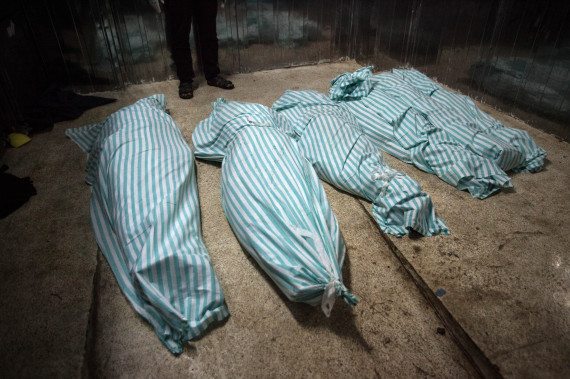As the members of the United Nations debate a Russian proposal to force the Syrian regime of President Bashar Assad to surrender its chemical weapons, HuffPost World looks back at the history of the conflict in the country.
* In the spring of 2011, Syrians took to the streets. They were inspired by the protests in Tunisia and wanted to bring about economic and political change.
* The Syrian government responded to the demonstrations by arresting a group of children and teenagers for writing political graffiti. When efforts to have the children released were ignored, the protests spread. That is when President Bashar Assad, whose family has ruled the country for four decades, decided to follow in his father's footsteps and use violence to quell the opposition. The regime ordered security forces to end the demonstrations, with violence if necessary, and hundreds of protesters were arrested, imprisoned and tortured.
* Assad suspended most constitutional protections, banned spontaneous rallies, restricted media freedom, permitted arbitrary detention and allowed the violent crackdown on protesters to continue. The U.S. and the EU responded by imposing or tightening sanctions for what they termed gross violations of human rights.
 In a Tuesday, June 5, 2012, file photo, a Syrian boy sits in the rubble of house which was destroyed during a military operation by the Syrian army in April 2012, in the town of Taftanaz, 15 kilometers east of Idlib, Syria. (AP Photo/Khalil Hamra, File)
In a Tuesday, June 5, 2012, file photo, a Syrian boy sits in the rubble of house which was destroyed during a military operation by the Syrian army in April 2012, in the town of Taftanaz, 15 kilometers east of Idlib, Syria. (AP Photo/Khalil Hamra, File)
* Over the next year, skirmishes were fought all over the country. The clashes devolved into bloodbaths and prompted the start of a civil war. In Homs, known as the “Capital of the Revolution,” thousands gathered in the main square on April 17 for a peaceful sit-in demonstration. Assad sent in government security forces, which killed at least 62 people. Over the next two years, the streets of Homs became the epicenter for the battle between the Syrian Army and the opposition. Clashes occurred on almost a daily basis as authorities blocked access to food, fuel and medical care. Rebels fought back with car bombs and sniper fire, often killing civilians in the crossfire. Control of the city has switched hands many times; these pitched battles have forced thousands of residents to flee and reduced buildings to rubble.
* During this time, the opposition formed the Syrian National Coalition for Opposition and Revolutionary Forces. This group was intended to bring together members of different sects within the country that were opposed to Assad. The coalition's mission statement notes: “Because of the deep crisis in Syria, our country, and the struggle our people are facing, all political opposition factions and have come together in unity with the goal of overthrowing the Assad regime, ending the suffering of the Syrian people, and to make the transition towards a free and democratic country. This coalition will comprise of leadership that will mobilize efforts to support and strengthen our people and represent the goals of this revolution in the best way possible.“ In December, dozens of countries recognized the coalition as the sole representative of the Syrian people.
* The coalition is supported by the Free Syrian Army, which is mostly comprised of former Syrian police officers and soldiers. The Free Syrian Army, which numbers between 50,000 and 100,000, also includes untrained citizens, who simply rose up against an oppressive regime. Without a central command structure, communication and coordination between its members remains difficult.
* The rebel army's ranks have also been assisted by extremists from other countries in the region. These fierce and organized fighters joined the rebels to stop Assad because they have a religious opposition to his Alawite regime and to gain a foothold in the region. Experts say the al-Nusra Front, an offshoot of the group al Qaeda in Iraq, is among the most effective forces in Syria. But to date, the intelligence community has been unable to agree on how many militant forces are working in the country. This lack of clarity makes the idea of giving arms and training to the rebels an unappealing one.
* In March 2012, former U.N. Secretary General Kofi Annan went to Syria to seek a cease-fire and to get Assad to release the detained protesters. His mission was initially thwarted by the Syrian government, but then Assad said he would end the violence and allow humanitarian groups access to the people. Alas, the violence continued.
* In August 2012, Lakhdar Brahimi was appointed by the United Nations as the new peace envoy to Syria. After meeting with Assad and other officials, a cease-fire was announced in October, just in time for Muslim holiday of Eid al-Adha, the feast of the sacrifice which marks the end of the annual hajj pilgrimage to Mecca. The cease-fire quickly collapsed, however, as both sides resumed fighting.
 The Al Zaatary camp for Syrian refugees is seen on Aug. 6, 2012, near the border with Syria. (Photo by Jordan Pix/ Getty Images)
The Al Zaatary camp for Syrian refugees is seen on Aug. 6, 2012, near the border with Syria. (Photo by Jordan Pix/ Getty Images)
* In July 2012, the head of the Syrian Foreign Ministry threatened to use chemical and biological weapons against what he described as "outside forces." This threat was one of the many reasons Annan decided to walk away from the peace mission. The threat also inspired many officials in the Syrian regime to defect. President Barack Obama issued his "red line" mandate, saying the use of chemical weapons would cause him to "change my calculus."
* By spring 2013, reports of chemical weapon attacks started trickling out of Syria. Doctors Without Borders, a medical charity, confirmed that more than 3,000 patients had been treated for exposure to chemical attacks. More than 300 of the victims died.
* On Aug. 21, 2013, an alleged chemical attack killed hundreds of people in the eastern Damascus suburbs. In response, the U.N. called for weapons inspectors to investigate. The team's efforts were briefly delayed by snipers, but it is unknown who was doing the shooting. However, while the inspectors were still trying to reach the affected towns, Syrian military planes bombed the area. The bombing, to some, made it clear that the regime was responsible for the attack and simply trying to hide evidence.
 Bodies lie at a morgue following fighting between rebel fighters and Syrian government forces on Aug. 10, 2013, in the northern city of Raqqa. (ALICE Martins/AFP/Getty Images)
Bodies lie at a morgue following fighting between rebel fighters and Syrian government forces on Aug. 10, 2013, in the northern city of Raqqa. (ALICE Martins/AFP/Getty Images)
It has been incredibly difficult for the press to cover the events in Syria because both sides keep killing or kidnapping journalists. Foreign journalists are generally barred from entering Syria, and some have concealed their identities in order to conduct interviews and report on events. That being said, according to estimates from the U.N. and human rights groups:
* More than 100,000 Syrians have been slaughtered since the start of the conflict.
* More than 2 million Syrians have been forced to flee the country.
* Another 5 million have become internally displaced.
* Almost half of the refugees are girls and women -- who face terrifying conditions at home and inside refugee camps -- while another quarter are boys under the age of 18.
* Most Syrian children have been unable to attend school for two years.
* Numerous cultural and historical artifacts have been looted and sold on the black market.
 Syrian refugees gather for food aid at Kawergost refugee camp in Irbil, 217 miles (350 kilometers) north of Baghdad, Iraq, Wednesday, Aug. 21, 2013. (AP Photo/Hadi Mizban)
Syrian refugees gather for food aid at Kawergost refugee camp in Irbil, 217 miles (350 kilometers) north of Baghdad, Iraq, Wednesday, Aug. 21, 2013. (AP Photo/Hadi Mizban)
Although the U.N. team's findings will officially be released later this month, the U.N. envoy to Syria announced a chemical weapon (likely sarin gas) was used on the country's people. However, proof of responsibility has not been released. Secretary of State John Kerry said U.S. intelligence has learned that 1,429 people were killed in the August chemical attack, including at least 426 children.
* U.N. Secretary General Ban Ki-moon said the use of chemical weapons in Syria is a crime against humanity and must be punished. However, he wants the U.N. Security Council to deal with Syria, rather than individual countries.
"I take note of the argument for action to prevent a future use of chemical weapons," Ban said. "At the same time, we must consider the impact of any punitive measure on efforts to prevent further bloodshed and facilitate the political resolution of the conflict."
 Ban Ki-moon. (AP Photo/Frank Franklin II, File)
Ban Ki-moon. (AP Photo/Frank Franklin II, File)
* Russia and China are against any sort of military intervention because both countries have economic interests in Syria, particularly from weapons sales. China has said that such an incursion would push up oil prices and create an economic downturn. And Russia has a base at the Syrian port of Tartus, giving the Russian navy its only direct access to the Mediterranean.
* On Sept. 4, the Senate Foreign Relations Committee voted to let Obama mount a bombing campaign aimed at the Syrian regime's weapons of mass destruction for up to 90 days. The resolution was more limited in scope than the president originally wanted, and included language specifically prohibiting the use of U.S. troops on the ground "for the purpose of combat operations." * On Monday, Kerry said Assad could resolve the crisis by surrendering control of "every single bit" of his arsenal to the international community by the end of the week. Russia then suggested that Syria place its chemical arsenals under international control, and destroy them to avert a U.S. military strike. This plan was backed by Ban, who said he will also propose to the Security Council that it demand an immediate chemical weapons transfer should U.N. inspectors conclude that such weapons were used in the Aug. 21 attack.
* In the meantime, U.S. opposition to an American-led military strike on Syria continues to grow. According to the latest Pew Research/USA Today report, the percentage of Americans opposing military action rose 15 points in the past week, from 48 percent in a survey ending Sept. 1 to 63 percent in a survey ending Sept 8.
* Members of the House of Representatives also appear to be against a strike, with 238 leaning toward voting no and only 41 voting yes as of a Monday count. In the Senate as of Monday night, 30 members are expected to vote yes, 34 plan to vote no and 36 votes are unknown or undecided. In an interview with NBC News on Monday, Obama said he hadn't decided whether to launch a military strike on his own if Congress votes down the resolution, but that he was taking the vote and the will of the American people "very seriously."
 Syrian children warm themselves at a refugee camp near the Turkish border, in Azaz, Syria, Sunday, Dec. 9, 2012. (AP Photo/Manu Brabo)
Syrian children warm themselves at a refugee camp near the Turkish border, in Azaz, Syria, Sunday, Dec. 9, 2012. (AP Photo/Manu Brabo)

